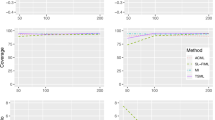Abstract
Among the wide variety of procedures to handle missing data, imputingthe missing values is a popular strategy to deal with missing itemresponses. In this paper some simple and easily implemented imputationtechniques like item and person mean substitution, and somehot-deck procedures, are investigated. A simulation study was performed based on responses to items forming a scale to measure a latent trait ofthe respondents. The effects of different imputation procedures onthe estimation of the latent ability of the respondents wereinvestigated, as well as the effect on the estimation of Cronbach'salpha (indicating the reliability of the test) and Loevinger'sH-coefficient (indicating scalability). The results indicate thatprocedures which use the relationships between items perform best,although they tend to overestimate the scale quality.
Similar content being viewed by others
References
Dempster, A. P. & Rubin, D. B. (1983). Overview. In:W. G. Madow, I. Olkin & D. B. Rubin (eds), Incomplete Data in Sample Surveys, Vol. II: Theory and Bibliographies. New York: Academic Press, pp. 3–10.
Greenlees, J. S., Reece, W. S. & Zieschang, K. D. (1982). Imputation of missing values when the probability of response depends on the variable being imputed. Journal of the American Statistical Association 77: 251–261.
Hendriks, A. A. J. (1997). The Construction of the Five-Factor Personality Inventory (FFPI). PhD Dissertation, The Netherlands: University of Groningen.
Hunt, S. M., McKenna, S. P. & McEwen, J. (1993). Nottingham Health Profile (NHP). In: C. Koenig-Zahn, J. W. Furer & B. Tax (eds), Het meten van de gezondheidstoestand; 1-Algemene gezondheid. Assen: Van Gorcum, pp. 100–114.
Huisman, M. (1998). Missing data in behavioral science research: Investigation of a collection of data sets. Kwantitatieve Methoden 57: 69–93.
Kromrey, J. D. & Hines, C. V. (1994). Nonrandomly missing data in multiple regression: An empirical comparison of common missing-data treatments. Educational and Psychological Measurement 54: 573–593.
Landerman, L. R., Land, K. C. & Pieper, C. F. (1997). An empirical evaluation of the predictive mean matching method for imputing missing values. Sociological Methods & Research 26: 3–33.
Little, R. J. A. (1988). Missing-data adjustments in large surveys. Journal of Business & Economic Statistics 6: 287–296.
Little, R. J. A. & Rubin, D. B. (1987). Statistical Analysis with Missing Data. New York: Wiley.
Little, R. J. A. & Schenker, N. (1995). Missing data. In: G. Arminger, C. C. Clifford & M. E. Sobel (eds), Handbook of Statistical Modeling for the Social and Behavioral Sciences. New York: Plenum Press, pp. 39–75.
Lord, F. M. & Novick, M. R. (1968). Statistical Theories of Mental Test Scores. Reading: Addison-Wesley.
Mokken, R. J. (1997). Nonparametric models for dichotomous responses. In: W. J. van der Linden & R. K. Hambleton (eds), Handbook of Modern Item Response Theory. New York: Springer-Verlag, pp. 351–367.
Molenaar, I.W. & Sijtsma, K. (1984). Internal consistency and reliability in Mokken's nonparametric item response model. Tijdschrift voor Onderwijsresearch 9: 257–268.
Rubin, D. B. (1976). Inference and missing data. Biometrika 63: 581–592.
Rubin, D. B. (1987). Multiple Imputation for Nonresponse in Surveys. New York: Wiley.
Sande, I. G. (1982). Imputation in surveys: Coping with reality. The American Statistician 36: 145–152.
Sande, I. G. (1983). Hot-deck imputation procedures. In: W. G. Madow, I. Olkin & D. B. Rubin (eds), Incomplete Data in Sample Surveys, Vol. III: Proceedings of the Symposium. New York: Academic Press, pp. 339–349.
Schafer, J. L. (1997). Analysis of Incomplete Multivariate Data. London: Chapman & Hall.
Schulte Nordholt, E. (1998). Imputation: Methods, simulation experiments and practical examples. International Statistical Review 66: 157–180.
van der Zee, K. I. & Sanderman, R. (1993). Het meten van de algemene gezondheidstoestand met de RAND-36: Een handleiding. [Measuring the general state of health with the RAND-36: A manual.] Groningen: Northern Center for Healthcare Research (NCG).
Author information
Authors and Affiliations
Rights and permissions
About this article
Cite this article
Huisman, M. Imputation of Missing Item Responses: Some Simple Techniques. Quality & Quantity 34, 331–351 (2000). https://doi.org/10.1023/A:1004782230065
Issue Date:
DOI: https://doi.org/10.1023/A:1004782230065




